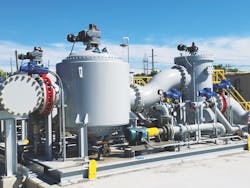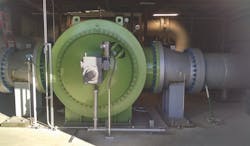About the author:
Del Williams is a technical writer based in Torrance, California, who writes about health, business, technology, and educational issues. Williams can be reached at 800.778.5689.
For municipal water authorities, pre-filtration of water is critical to protect and extend the life of membrane systems, as well as increase intervals between backwashing or necessary maintenance.
Pressure-driven membrane systems utilize thin, porous sheets of material to separate contaminants from water. The technology, in the form of microfiltration, ultrafiltration, reverse osmosis filtration and nanofiltration membranes, provides superior water quality with little waste. Because of this, it is commonly used for potable water production and advanced wastewater treatment, including “purple pipe” reclaimed and recycled wastewater applications.
However, without adequate pre-filtering of the water entering the membranes, such systems can be susceptible to irreparable damage from large particles. In addition, water that is not adequately pre-filtered can cause excessive membrane fouling, leading to sub-par water production as well as costly, premature replacement and unscheduled production downtime.
Fortunately, a growing number of municipalities are ensuring superior water quality, as well as membrane longevity and reliable production, utilizing low maintenance, multi-element, self-cleaning pre-treatment filters.
Optimizing Membrane Longevity
When a municipal water utility plant in the Southeast U.S. sought to protect its membranes filters, a reliable pre-filtering system was necessary.
According to an instrumentation technician who installs, programs, configures and troubleshoots monitoring devices in the drinking water facility, as soon as the water was pulled from the wells, it was put through a strainer. From there, it entered to other parts of the plant for further treatment and cleaning with membrane filtration utilized at the end of the process.
The straining was necessary due to sediment in the water, particularly sand. If this sand were to pass through, it would destroy the membrane just as any other large particle would. This would result in an expensive replacement for the facility and was not ideal.
While the plant had utilized a sand strainer, the instrumentation technician felt this was too small for the plant’s volume, which produces millions of gallons of drinking water per day.
In response, plant management turned to a multi-element, self-cleaning pre-treatment filter from R. P. Adams, which first introduced and patented the technology in the 1960s and now has installations in plants around the world.
This design provides an alternative to sand filters, centrifugal separators and basket type strainers. Unlike those designs, which have limitations in particle size filtration and also require regular maintenance, the multi-element, self-cleaning pre-treatment filter can provide continuous removal of suspended solids. When utilized as the “first line of defense” for pre-membrane water filtration, it typically filters out sand, silt and other suspended solids from 500 to 75 µ.
Another significant feature of the multi-element design is the backwash mechanism. With traditional strainers, the backwash mechanism comes into direct contact with the straining media. This can be problematic as large, suspended solids often encountered with raw water can become lodged between the straining media and the backwash arm. The result is straining media damage and/or rupture that can compromise membranes and other downstream equipment, hindering plant operation.
Instead, the multi-element design includes a tube sheet to separate the straining media from the backwash mechanism. This prevents the backwash mechanism from coming into contact with the media and damaging the elements caused by large solids becoming lodged between the media and the backwash arm.
According to the instrumentation technician, the pre-filter has helped to prolong the usable life of the drinking water facility’s main membrane.
With the addition of pre-filtration, membrane life hits around seven years before it needs to be replaced, according to the technician. If that equipment were not installed, he said the replacement period would come considerably quicker.
Municipal water plants also need to consider how to best reduce membrane fouling and required maintenance. Traditional strainers, however, can become clogged quickly, due to limitations in the straining area. When that occurs, cleaning, media replacement or backwashing is necessary, which adversely affects productivity as well as maintenance costs.
In this regard, the multi-element design provides three to four times the surface area of traditional strainers and pre-filters. This translates directly into less frequent backwashing, meaning less water goes to waste, less power is consumed and less maintenance is required. The instrumentation technician also noted that since installation, the equipment has performed without issue.
When considering pre-filter technology for municipal potable water or wastewater systems, automatic multi-element, self-cleaning, pre-treatment filters are an increasingly popular choice and a reliable, cost effective solution.
About the Author
Del Williams
Del Williams is a technical writer based in Torrance, California.He writes about health, business, technology, and educational issues,and has an M.A. in English from C.S.U. Dominguez Hills.


